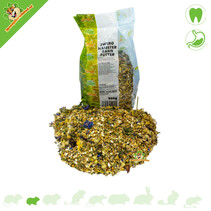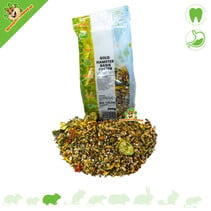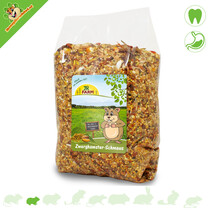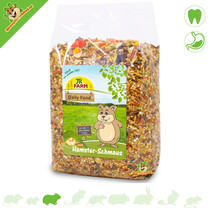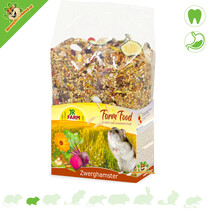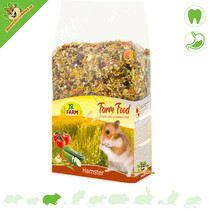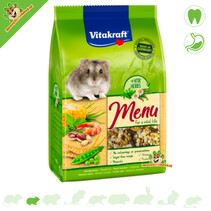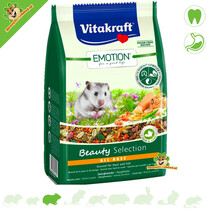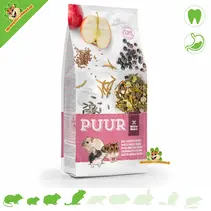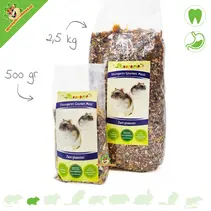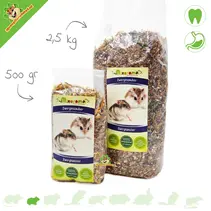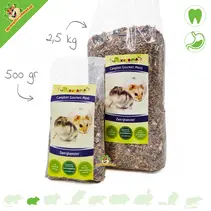Food for Hamsters & Dwarf Hamsters in the Hamster Webshop!
- Ordered before 5 p.m., shipped the same day!
- Al 14 jaar een begrip!
- Delivery from our own stock
- Ordered before 5 p.m., shipped the same day!
- Al 14 jaar een begrip!
- Delivery from our own stock
Order Hamster Food & Dwarf Hamster Food easily and quickly at DRD Rodent Shop ® The online Hamster Webshop for your Hamster!
 For food for your Hamster or Dwarf Hamster you are in the right place in our Hamster webshop . You will find different types and brands of hamster and dwarf hamster food for an attractive price. Little One, Bunny Nature, Witte Molen, Hope Farms, Versele Laga, Beaphar etc. Ordering is easy and fast in our Hamster webshop.
For food for your Hamster or Dwarf Hamster you are in the right place in our Hamster webshop . You will find different types and brands of hamster and dwarf hamster food for an attractive price. Little One, Bunny Nature, Witte Molen, Hope Farms, Versele Laga, Beaphar etc. Ordering is easy and fast in our Hamster webshop.
What is the best hamster food?
The best hamster food is food that:
- Varied in composition (seeds, grains, vegetables, animal proteins, herbs).
- Meets the natural nutritional needs of your hamster species.
- Contains sufficient crude fibre for healthy digestion.
- Contains animal proteins (such as mealworms or shrimp), especially important for Syrian hamsters.
- Contains no added sugars, colourings or fillers .
Why is variety in hamster food important?
Variation:
- Prevents nutrient deficiencies.
- Stimulates foraging behavior (natural searching and gathering behavior).
- Prevents boredom.
- Helps hamsters use and keep their teeth healthy.
Please note: too little variation or only “pressed pellets” is unnatural and insufficiently rich.
Nutritional requirements of the Hamster and the Dwarf Hamster
Hamsters and Dwarf hamsters are granivores (seed eaters) . The diet of both Hamsters and Dwarf hamsters consists mainly of seeds and a small amount of vegetable food in the form of herbs , but also animal proteins . Hamsters catch small insects in the wild, so it is good if their diet also contains animal proteins.
The nutritional needs of the different hamster species differ from each other:
Roborovski Dwarf Hamster: seeds, very little animal food
Russian Dwarf Hamster: Seeds, Grasses and Herbs, Insects
Campbell's Dwarf Hamster: Seeds, Grasses and Herbs, Insects
Chinese Dwarf Hamster: seeds and no grasses or herbs. The protein content is zero.
Syrian Hamster (Golden Hamster): seeds, grains, insects
Which nutrients are essential for hamsters?
- Proteins : minimum 16% (for young and active hamsters); source: mealworms, shrimps, silkworms.
- Fats : approx. 4–7%, important for energy.
- Fiber : good for the intestines; source: vegetables, herbs, fiber pellets.
- Carbohydrates : through grains and seeds.
- Vitamins/minerals : through vegetables, fruit, nuts and herbs.
Is every hamster food suitable for all ages?
In itself yes, but
- Young hamsters (up to 10-12 weeks) need extra proteins.
- Adult hamsters do well on a balanced diet.
- Senior hamsters (from 1.5 years) benefit from less energy, more fiber and more easily digestible food.
Tip: Rodipet or Mixerama Senior foods are perfectly suited for older hamsters.
Should I give my Hamster anything additional besides basic food?
Yes! Think about:
- Fresh vegetables (carrot, broccoli, pepper).
- Dried flowers or herbs ( chamomile , plantain , marigold ).
- High protein snacks (1–2x/week): silkworms , mealworms , grasshoppers .
- Gnawing material in the form of gnawing wood or twigs for gnawing.
Do not feed: citrus, onion, garlic, leek, chocolate, or sugary fruits (such as grapes).
Foraging Tip!
 Did you know that we have developed a special Foraging Menu for hamsters ? This tasty and healthy mix is suitable for hamsters of all ages - from very young adventurers to calm seniors.
Did you know that we have developed a special Foraging Menu for hamsters ? This tasty and healthy mix is suitable for hamsters of all ages - from very young adventurers to calm seniors.
✔ 100% Natural and Non-GMO: Our menu contains only natural ingredients and non-GMO sources. We believe in purity and quality, so that your hamster and other small friends can enjoy food that comes straight from nature
✔ A World of Taste and Texture: Let your little rodents discover and enjoy a variety of tastes and textures. From crunchy nuts, crunchy herbs to juicy fruits, every bite offers an adventure for your pets' taste buds
✔ Nutritious and Balanced: Our forage menu is not only tasty, but also nutritious! With the right balance of grains, seeds, nuts, and fruits, we provide your small rodents with the essential nutrients they need for a healthy and active life
You can use the Foraging Menu as an enrichment to stimulate your hamster's natural foraging behavior, but it is also complete and balanced enough to give as a main food . This way your hamster not only stays busy, but also gets all the nutrients he needs.
What does 'species specific' food mean?
This means that the food is tailored to the type of hamster :
- Syrian hamsters (golden hamsters) : need more animal proteins.
- Dwarf hamsters (such as Campbell's Dwarf Hamster , Roborovski Dwarf Hamster or the Russian Dwarf Hamster ): are more sensitive to sugar and should be fed a low-sugar diet.
- Hybrid hamsters : also sensitive to sugar → choose sugar-free food such as Bunny, JR Farm, Getzoo or Mixerama.
What are possible contraindications in food?
Contraindications are ingredients that can have negative effects on your hamster's health:
- Added sugars → risk of diabetes in dwarf hamsters.
- Colorants and flavorings → unnecessary and sometimes harmful.
- Too many nuts or fatty seeds → can cause obesity.
- Animal by-products without specification → unclear what it is.
Avoid brands that are vague about composition (such as only “vegetable by-products”) We do too!
Can I combine different brands?
Yes, you can – but do this gradually :
- Mix the old and new food over a few days.
- Be careful not to create deficiencies or surpluses (e.g. too much fat or protein).
- Preferably combine brands with transparent ingredient lists .
How do I encourage foraging behavior with hamster food?
- Hide food in paper, toilet rolls or foraging balls.
- Sprinkle it loosely in the enclosure (no food bowl!).
- Offer snacks in food puzzles or homemade search games.
This will keep your hamster active, mentally challenged and happy!
How do I know if my hamster tolerates its food well?
NB:
- Regular and healthy droppings.
- Good coat condition.
- Active behavior.
- No weight loss or gain.
Tip : Weigh your hamster weekly (kitchen scale). An adult Syrian hamster weighs approx. 120–200 grams; dwarf hamsters approx. 25–55 grams.
What do we look for in case of overweight?
Ideal characteristics of food for overweight hamsters:
- Low fat content (less fatty seeds such as sunflower seeds).
- Sugar free (no fruit pieces, honey, raisins etc.).
- Rich in fiber (more vegetable and herb components).
- Natural ingredients , no colorants, flavors or fillers.
- No added sugars or “vegetable by-products”.
Digestive tract of different hamster species and their differences
1. Roborovski dwarf hamster
The Roborovski dwarf hamster generally has a relatively short intestine and large intestine compared to other hamster species. Due to their dietary preference for seeds and grains, they may have efficient digestion in the small intestine, where nutrients are absorbed. They have a relatively fast intestinal transit, meaning that food is processed quickly through the digestive tract.
2. Russian Dwarf Hamster
The Russian dwarf hamster tends to have a longer digestive tract compared to other hamster species. They have a relatively larger large intestine, which may indicate better fermentation of fiber and more efficient digestion of plant material. Their diet consists of a wide variety of foods, including seeds, grains, vegetables, and fruits.
3. Chinese Dwarf Hamster
The Chinese dwarf hamster has a relatively long and tortuous digestive tract, which can help slow the passage of food and aid in efficient digestion. They have a relatively large caecum, a part of the large intestine where fermentation takes place. This can indicate that they are well adapted to a high-fiber diet. Their diet consists mainly of seeds, grains, vegetables, and insects.
4. Campbell's dwarf hamster
The Campbell's Dwarf Hamster has similar characteristics to the Russian Dwarf Hamster. They have a medium length digestive tract and medium size digestive organs. They have a similar diet to the Russian Dwarf Hamster, with a mix of seeds, grains, vegetables, and fruits.
5. Syrian hamster
The Syrian hamster generally has a larger digestive tract size compared to the dwarf hamster species. They have a relatively large stomach and intestines, which may indicate better processing of food. Their diet consists of a wide variety of foods, including seeds, grains, vegetables, fruits, and insects.

Hoarding the Hamster and the Dwarf Hamster
Hamsters & Dwarf hamsters transport their food in their cheek pouches . What you see is that the hamster stuffs its food in its cheek pouches and quickly takes it to its home or pantry. Transporting food in the cheek pouches is also called 'Hoarding' . Thanks to the cheek pouch muscle, the food is held in the cheek pouch and the hamster can transport it safely and quickly.
All in one chunk or a mixture?
If your hamster or dwarf hamster really starts eating selectively , so that he only eats the tasty things, then it may be wise to switch to an all-in-one kibble . In this way, the hamster can no longer eat selectively. Each kibble has its own composition. Hamsters do need a few weeks to get used to other food. It is also possible that the hamster will eat less of the all-in-one kibble. This may have to do with the composition of the kibble. Some all-in-one kibbles have a very full composition, so that less of it needs to be eaten to meet the same nutritional needs.
Is it good to switch hamster foods?
Hamsters are much less sensitive to a change of food than for example a guinea pig or rabbit. Changing between food is much easier with these animals. However, we advise to always mix your own food with the new food for a few days.
Coprophagy in Hamsters and Dwarf Hamsters
Hamsters produce two types of feces: dry, hard feces and soft, nutrient-rich feces called caecotrophs. Caecotrophs are produced in the caecum, an extension of the large intestine. They contain undigested nutrients, such as fiber and protein.
When hamsters produce caecotrophs, they eat them directly from their anus. The purpose of this is to reabsorb nutrients that have not been fully digested or absorbed during the first pass through the digestive system. In this way, hamsters maximize nutrient absorption and improve their digestive efficiency.
Coprophagy is a natural behavior in hamsters and plays an important role in their feeding strategy. It allows them to obtain essential nutrients that would otherwise be lost. However, it is important to ensure that hamsters are fed a balanced diet that contains sufficient nutrients so that they are not forced to engage in coprophagy to compensate for deficiencies.
The Teeth of Dwarf Hamsters and Hamsters
Hamsters have specific characteristics when it comes to their teeth.
Incisors: Hamsters have two pairs of incisors at the front of their mouths, an upper pair and a lower pair. These incisors grow continuously throughout their lives. This constant growth process is necessary because the incisors wear down from chewing and gnawing. It helps keep the incisors sharp and prevents overgrowth.
Growth Rate: A hamster's incisors grow an average of 2 to 3 millimeters per week. This is why hamsters need constant chewing material to wear down their teeth and keep growth under control.
Chewing and Gnawing: Hamsters have a natural urge to chew and gnaw. This behavior is essential for maintaining healthy teeth and preventing dental disease. Chewing on hard foods and chew toys helps wear down the incisors and stimulates blood flow to the area.
Dental problems: If a hamster's incisors do not wear down properly, dental problems can occur, such as overgrowth, crooked teeth or even broken teeth. These problems can be painful and can prevent the hamster from eating. Regular dental checks and providing sufficient chewing material are important to prevent dental problems.
Diet: A hamster's diet plays an important role in the health of their teeth. Providing nutritious food and fiber-rich foods will help naturally wear down their teeth. Additionally, hamsters should always have access to fresh water to prevent dehydration, which can also affect their dental health.
It is important to check your hamster's teeth regularly for any abnormalities, overgrowth, or other problems. If you notice any changes or have any concerns about your hamster's dental health, consult a veterinarian who has experience with small pets.
The Stomach of Hamsters and Dwarf Hamsters
Hamsters have a unique stomach structure that is adapted to their diet and digestive needs.
Stomach Pouches: Hamsters have two stomach pouches, also known as "fermentation chambers" or "crop pouches." These pouches are located at the beginning of the stomach and play a role in the digestion of fiber-rich foods, such as grass and hay. The stomach pouches act as a kind of fermentation chamber where bacteria break down fiber and release nutrients.
Pylorus: The pylorus is the part of the stomach that borders the small intestine. It regulates the passage of food from the stomach to the small intestine. In hamsters, the pylorus is well developed to control the passage of food and optimize digestion.
Stomach acid: Hamsters have a relatively low acidity in their stomachs compared to some other species. This is because they are primarily herbivores and their diet consists mainly of plant material. The lower acidity helps with the digestion of fiber-rich foods and facilitates the growth of bacteria necessary for the fermentation processes in the stomach pouches.
Capacity: Hamsters generally have a limited stomach capacity, as they are smaller animals. They tend to have smaller stomach sizes relative to their body size. This means that hamsters can process smaller amounts of food at a time.
The intestines of hamsters and dwarf hamsters
Hamsters have a complex digestive system, including intestines, that allows them to absorb nutrients from their food.
Small Intestine: The small intestine is responsible for most of the digestion and absorption of nutrients. It is made up of three parts: the duodenum, jejunum, and ileum. In these parts, enzymes and other digestive juices are released to further break down food and absorb nutrients.
Cecum and appendix: Hamsters have enlarged cecums and appendixes, indicating their ability to digest fiber-rich foods such as grass and hay. These parts of the intestine contain bacteria and microorganisms that can break down cellulose and carry out fermentation processes to release nutrients.
Large Intestine: The large intestine follows the small intestine and is responsible for absorbing water and electrolytes from undigested food. It also helps form and store feces before it is excreted.
Rectum and anus: The rectum is the last part of the intestinal tract where feces are stored before being excreted. The anus is the end of the digestive tract where feces exit the body.
Can hamsters digest fiber well?
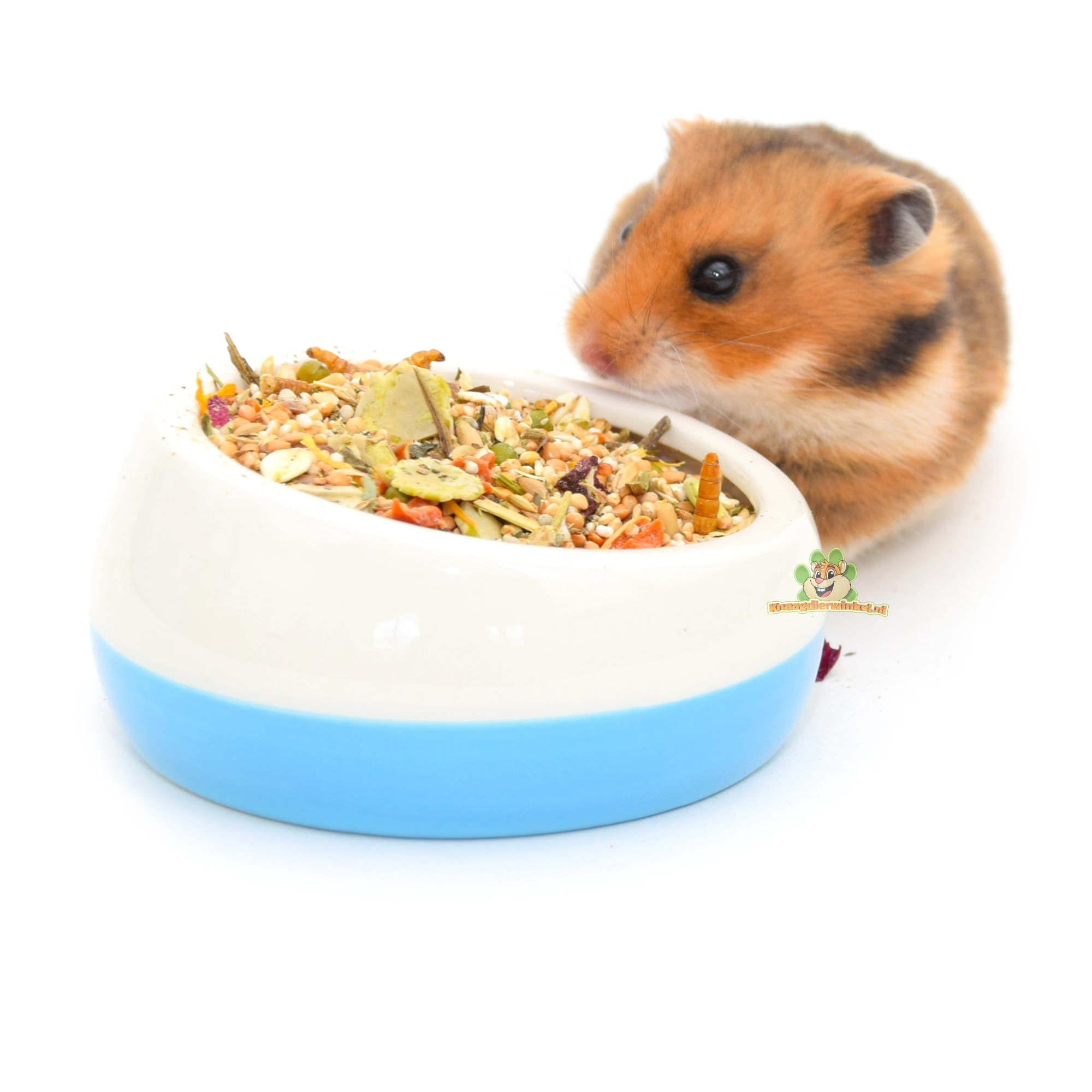 Hamsters have a reasonable ability to digest fiber, but their ability is not as efficient as that of rabbits. Fiber-rich foods, such as hay, vegetables, and greens, are important for hamsters’ gut health and digestion. They help promote healthy gut flora, stimulate bowel movements, and contribute to good bowel movements.
Hamsters have a reasonable ability to digest fiber, but their ability is not as efficient as that of rabbits. Fiber-rich foods, such as hay, vegetables, and greens, are important for hamsters’ gut health and digestion. They help promote healthy gut flora, stimulate bowel movements, and contribute to good bowel movements.
Although hamsters can digest fiber, they are generally better adapted to a mixed diet that also includes grains, seeds, and proteins. They have a shorter gastrointestinal tract compared to rabbits, which means they have less time to fully break down and ferment fiber. Therefore, it is important to provide other foods that meet their nutritional needs in addition to fiber-rich foods.
Are hamsters granivores?
Granivores are animals that have a diet consisting mainly of seeds and grains. This also applies to many hamster species.
Hamsters have modified teeth and jaws that allow them to crack and eat seeds and grains. They prefer foods such as sunflower seeds, oats, barley, wheat, and other grains. These seeds and grains provide important nutrients, such as carbohydrates, fats, and proteins, which are essential for the health and energy needs of hamsters.
Although hamsters can eat other plant materials such as vegetables, fruits, and grass, seeds and grains generally make up the majority of their diet, making them primarily granivores.
Are Hamsters Omnivores?
Hamsters can be considered both granivores and omnivores, depending on their specific diet and dietary preferences. In general, hamsters have a plant-based diet and specialize in eating seeds, grains, and other plant materials. This makes them granivores.
However, some hamster species can also include small amounts of animal protein in their diet. This can include insects, larvae, or small amounts of animal meat. Adding these animal proteins to their diet can serve as a supplementary food, but generally does not form a large part of their daily diet.
The natural rhythm of food gathering
Hamsters are natural foragers and only have food available for a short period of time. In the winter, everything starts to become scarce and so they have to do their utmost in the summer to fill up the food supplies. The dwarf hamster is therefore always busy looking for and storing food. This behavior is very recognizable for many hamster owners.
The hamster follows its natural rhythm when it comes to collecting food. It does not realize that the summer and the availability of food in our home are endless. It happily continues to collect and if you let it do its thing, a large supply is created.
Energy-rich food first
In the wild life is hard, those who have not collected enough will not make it. Those who do not have enough fat reserves will get cold and difficult. This is the main reason why hamsters eat energy-rich food first. Their instincts force them to do so. Energy-rich food provides energy and makes it possible to build up a layer of fat. The latter helps against the cold and provides a buffer for when things go wrong with finding food. The animals do not have to be afraid of this in our homes, they simply do not know and that is why they continue to eat energy-rich food first.
By energy-rich food we mean food with a higher content of: (natural) sugars, carbohydrates/starch and fats. The animals will therefore eat sweets (sugars/carbohydrates) first, followed by fruit (natural sugars), pea flakes (starch) and sunflower seeds (fats). This preference is also called selective eating .
Important: Carbohydrates, sugars and fats are essential for dwarf hamsters. They need these nutrients in large quantities to meet their energetic existence. Too much of these nutrients is not good, but too little is just as bad!
This is how we prevent selective eating!
Be strict!
There is actually one good way to prevent selective eating and that is to be strict . The animals should get the prescribed portion of food and only a new portion when the old one has been eaten. In this way, selective eating is no longer possible. However, many owners find it difficult to be so strict with their darling.
If you decide to suddenly be strict with feeding, you may see that your hamster will eat less. This is a natural reaction of the animal. Its food supply is getting smaller and that creates a feeling of scarcity. It has to eat less now or it won't make it through the winter (or so it thinks). The owner is shocked by this, my animal suddenly eats less and probably loses weight. These are signals that we don't like to see!
Adjust nutrition
It may help to switch to a food with a different composition or to remove the tasty things that the hamster takes from the food and only give them after the other things have been eaten.
All in one chunk
A last resort is the all-in-one chunk. These chunks are all the same, which means that there can be no selective eating behaviour and therefore no nutritional deficiencies. The all-in-one chunk does not fit completely into the menu of the natural food. The animals therefore need a longer period of getting used to it, but once they are used to an all-in-one chunk, they eat it very well and remain stable in terms of condition and weight.
For rabbits and guinea pigs, the all-in-one chunk is already completely established and is one of the primary ways of feeding. The animals are in better condition if they are fed an all-in-one chunk.
For an owner who wants to be 100% sure that his pet always gets all the nutrients it needs, the all-in-one kibble is the solution.
It remains an art to keep the hamster's eating habits in balance. Due to its collecting and therefore hiding behavior, it is sometimes quite a task to find all the food supplies. If your hamster eats selectively, but otherwise looks fine, there is no reason to panic. Some animals seem to eat selectively, but secretly balance their food in a good way. These animals have a good weight, beautiful fur and sparkling eyes.








